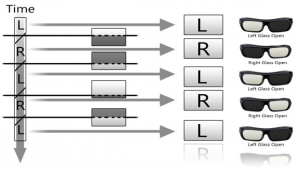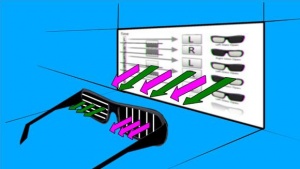Stereoscopic 3D: Difference between revisions
Remove rogue apostrophe |
|||
| Line 50: | Line 50: | ||
In games, the use of stereoscopy seemed to increase immersion and spatial presence. Although the effects differed between games, it seems that the use of S3D allows for a more natural and engaging experience <ref name=”3”></ref>. | In games, the use of stereoscopy seemed to increase immersion and spatial presence. Although the effects differed between games, it seems that the use of S3D allows for a more natural and engaging experience <ref name=”3”></ref>. | ||
One of the concerns regarding S3D technology is visual comfort. This has been a long-standing problem in stereoscopic research. It refers to the subjective sensation of discomfort associated with the viewing of stereoscopic images. This issue is not recent; in the past (mainly in the early | One of the concerns regarding S3D technology is visual comfort. This has been a long-standing problem in stereoscopic research. It refers to the subjective sensation of discomfort associated with the viewing of stereoscopic images. This issue is not recent; in the past (mainly in the early 1950s), there were some attempts to popularize 3D movies. These did not succeed due to the limited stereoscopic technology available at the time and due to visual discomfort (2). Current stereoscopic displays with a fixed screen plane can cause several human visual cues to conflict with each other, mainly accommodation and convergence. This leads to a negative experience associated with symptoms of visual fatigue like sore eyes, eye strain, headache, and blurred vision. In HMDs this effect also occurs. It has to be noted that the presence and intensity of the visual discomfort vary from person to person <ref name=”3”></ref>. | ||
==References== | ==References== | ||
Revision as of 08:59, 17 April 2024
Stereoscopic 3D (S3D) is a method of giving depth perception that exploits the binocular disparity depth cue to produce the illusion of depth. It can be used in still or moving images. It produces an illusion of depth by displaying two slightly different images left and right eyes.[1]. This ability is based on the characteristics of the human visual system.
The eyes, being positioned horizontally in the head, receive two views of the visual scene - one for the left-eye and another for the right-eye. The views overlap but differ slightly since they originate from two distinct perspectives. The visual system interprets and processes the information gathered from the two images to produce stereoscopic depth. The binocular system is very good at coordinating the movement of the eyes, which move constantly even during fixation. From a functional point of view, the images of both eyes fall on the fovea when fixating binocularly on a point. The fovea is the part of the back of the eye that has the highest acuity. According to Tam et al. (2011), “an object fixated binocularly is imaged on the same relative coordinates in the left-eye and right-eye views and it is perceived as a single percept, i.e., it is seen as a single object.” [2]
To look at a new object located at a different distance, the point of fixation is altered. The two eyes move at the same time and in opposite directions so that the new object is imaged in the center of each eye’s fovea. When the new object is closer the eyes move inward (convergence). On the contrary, when the new object is farther away the eyes move outward (divergence). This process is called vergence and it is related to accommodation [2].
After the success of James Cameron’s Avatar, stereoscopic 3D was promoted has having advantages in different media like movies, 3DTV, and games. Indeed, the Sony Playstation 3 and Nintendo 3DS offered stereoscopic 3D gaming in a console format. On PC, S3D was available through driver-based solutions like Nvidia 3D Vision or TriDef [3].
Back in 2010, S3D was on the cusp of becoming a mass consumer product, with cinemas showing an increasing number of movies in 3D, TV channels launching 3D broadcasts of sports events, and companies selling 3DTV sets and Blu-ray 3D players. Despite the technological advances, the practical production of S3D content that produces a natural and comfortable viewing experience is still a challenge. The challenge arises from the complex interplay of human visual perception and the restriction of display devices, which can lead to discomfort after prolonged use. The majority of the 3D display technology is based on displaying a stereo image on a flat screen. This has the advantage of reproducing stereo cues like vergence. On the other side, other depth-cues like accommodation are neglected. The discrepancy between accommodation and vergence generates distorted perception, visual fatigue, headache, and dizziness [4] [5].
While users who experimented with the technology - especially in gaming - where impressed by it, it did not have a major impact on the industry, mainly in the 3D TV´s market. In the home console market, Sony removed support for S3D with the PS4. In mobile gaming, Nintendo released a 2D alternative to the regular Nintendo 3DS, downplaying the 3D functionality of the handheld console. It seems that, in the case of S3D on TVs, the near-future belongs to 4K TV, that will be supported by console manufacturers and film studios. According to Tamburro (2015), one of the reasons for the problems stereoscopic 3D faced could be that “it’s difficult to sell a product that’s reliant upon the user experiencing it in order for them to understand its capabilities. While there will be the odd risk-taker who’s willing to plump down a wad of cash on something that could well turn out to be a failed experiment, the vast majority of people are far more sensible and choose to reserve their money unless they’re given a solid reason to part ways with it.” [6]
Technology and development



There are several techniques available used to create the illusion of a 3D image with the use of lenses. 3D displays use the same guiding principles as the visual system to exhibit depth. In each eye, slightly different perspectives are presented so that the brain uses the differences between them to give the sense of depth [7] [8] [9].
One of the techniques is polarization 3D, that can use active or passive polarized lenses (figure 1 and 2). Anaglyph 3D uses passive red cyan lenses or chromatically opposite colors. These can be considered the classic-type 3D glasses and are a type of passive lenses (figure 3). Head-mounted displays also provide S3D using a separate display optic very close to the eyes. Finally, autostereoscopic 3D is a technique that allows for 3D depth without glasses [2] [8].
Passive glasses do not require the use of batteries and do not need to be electronically linked to the display mechanism. They use optical filters to selectively sort the right and left images to the correct eye. Newer versions of this technology work by interlacing the left and right images together using a unique screen made of two emitting filters on top of one another. Gouraud (2011) wrote that “each image is displayed using a property of light called polarization. This allows the passive-polarized glasses to then selectively filter out light between two images using the corresponding polarized films. Therefore, each eyepiece must be polarized in a different direction, allowing separate images to be delivered to each eye. In this manner, a 3D effect is achieved.” [9]
Active shutter has been the primary technology used in home entertainment systems. The mechanism takes advantage of the high frame rates that are available in LED and plasma TVs (120 Hz and above). The TV displays two high definition pictures at a high refreshment frequency (>60 Hz) to achieve temporal multiplexing. The shutter glasses sync with the TV to actively filter the corresponding frames so that each eye only receives the intended image [9].
With the autostereoscopic display technology (also referred to as parallax barrier), there is no requirement for the users to wear glasses to achieve a three-dimensional effect. The technology relies on an optical filter which divides the images and enables it to direct light to each eye. This allows the viewer to perceive a coherent left and right image. The Nintendo 3DS uses this type of display technology [9].
Historical context
Stereoscopic vision has evolved during millions of years. It is a common feature between humans and many animals, generally predators. In these, two parallel aligned eyes deliver different perspectives of the same scene. Stereoscopic vision is an important sense that is vital for the survival of the animals who possess it [10].
Charles Wheatstone first developed the stereoscope in 1938. His research demonstrated that the brain processes the images from each eye into a single three-dimensional object. When two stereoscopic images were viewed side by side through a stereoscope, a sense of depth and immersion was created. The design principles of the stereoscope are still applied today in things like the Google Cardboard and low budget VR HMDs for mobile phones [11].
The popular View-Master stereoscope was patented in 1939, and was used for “virtual tourism”. In 1949 David Brewster suggested the use of lenses, giving rise to the lenticular stereoscope. The cinematographer Morton Heilig developed the Sensorama in the mid-1950s. It was an arcade-style theatre cabinet that stimulated all the senses. It had stereoscopic 3D display, stereo speakers, fans, smell generators, and a vibrating chair with the objective of immersing the viewer in the film. Heilig created six short films for the Sensorama. He was also responsible for the Telesphere Mask, that was patented in 1960. It was the first example of a HMD - although without motion tracking and for use with non-interactive film medium. This headset provided S3D and wide vision with stereo sound [11].
Devices
There are two categories of electronic S3D devices: the glasses-type mentioned before, that influence the way a user sees the image on a monitor, and devices that produce an image by themselves like HMDs [10].
High-end headsets use dual screens to create a stereoscopic 3D effect, with each screen presenting a slightly different image to each eye and creating the illusion of depth. Low-cost entry options are also available. The Samsung Gear VR uses a smartphone as the display, with the stereoscopic image being created by two replaceable lenses. In this case, the use of a smartphone means sacrificing field of view and graphical fidelity for a wireless headset [12].
These headsets also include options for adjusting the lenses, since each person has a different distance between the center of their pupils, to achieve a stereoscopic 3D effect [12].
Stereoscopic 3D benefits and visual discomfort
When compared to standard 2D TV, the S3D-TV technology has been said to increase the entertainment value of television programs. While the main benefit of 3D-TV is the greater depth perception, there is evidence that stereoscopic television could also enhance the perception of sharpness, sense of presence, and naturalness. According to some surveys, it seems that people would rather view S3D images than 2D, provided that there are no uncomfortable side effects [2].
In games, the use of stereoscopy seemed to increase immersion and spatial presence. Although the effects differed between games, it seems that the use of S3D allows for a more natural and engaging experience [3].
One of the concerns regarding S3D technology is visual comfort. This has been a long-standing problem in stereoscopic research. It refers to the subjective sensation of discomfort associated with the viewing of stereoscopic images. This issue is not recent; in the past (mainly in the early 1950s), there were some attempts to popularize 3D movies. These did not succeed due to the limited stereoscopic technology available at the time and due to visual discomfort (2). Current stereoscopic displays with a fixed screen plane can cause several human visual cues to conflict with each other, mainly accommodation and convergence. This leads to a negative experience associated with symptoms of visual fatigue like sore eyes, eye strain, headache, and blurred vision. In HMDs this effect also occurs. It has to be noted that the presence and intensity of the visual discomfort vary from person to person [3].
References
- ↑ Techopedia. 3-D Stereo Technology (S3-D). Retrieved from https://www.techopedia.com/definition/81/3d-stereo-technology-s3d
- ↑ 2.0 2.1 2.2 2.3 Tam, J. A., Speranza, F., Yano, S., Shimono, K. and Ono, H. (2011). Stereoscopic 3D-TV: Visual Comfort. IEEE Transactions on Broadcasting, 57(2)
- ↑ 3.0 3.1 3.2 Schild, J., LaViola Jr., J. J. and Masuch, M. (2012). Understanding User Experience in Stereoscopic 3D Games. Proceedings of the SIGCHI Conference on Human Factors in Computing Systems: 89-98
- ↑ Lang, M., Hornung, A., Wang, O., Poulakos, S., Smolic, A. and Gross, M. (2010). Nonlinear Disparity Mapping for Stereoscopic 3D. ACM Transactions on Graphics (TOG) - Proceedings of ACM SIGGRAPH 2010, 29(4)
- ↑ Read, J. C. A. and Bohr, I. (2014). User experience while viewing stereoscopic 3D television. Ergonomics, 57(8): 1140-1153
- ↑ Tamburro, P. (2015). How Virtual Reality Could Go the Way of Stereoscopic 3D. Retrieved from http://www.craveonline.com/design/938609-virtual-reality-go-way-stereoscopic-3d
- ↑ Hurricane Media (2011). Stereoscopic 3D filming and graphics, how 3D works [Video]. Retrieved from https://www.youtube.com/watch?v=IYm3BmnyVrg
- ↑ 8.0 8.1 Techopedia. 3-D Stereo Technology (S3-D). Retrieved from https://www.techopedia.com/definition/81/3d-stereo-technology-s3d
- ↑ 9.0 9.1 9.2 9.3 Gouraud, G. (2011). A Developer's Guide To Stereoscopic 3D In Games. Retrieved from http://www.gamasutra.com/view/feature/134827/a_developers_guide_to_.php?print=1
- ↑ 10.0 10.1 Stereo3d. Basics/Quick-Info. Retrieved from http://www.stereo3d.com/3dhome.htm
- ↑ 11.0 11.1 Virtual Reality Society. History Of Virtual Reality. Retrieved from https://www.vrs.org.uk/virtual-reality/history.html
- ↑ 12.0 12.1 Messner, S. (2016). How VR headsets actually work. Retrieved from http://in.ign.com/playstation-vr-project-morpheus-ps4/100417/feature/how-vr-headsets-actually-work

